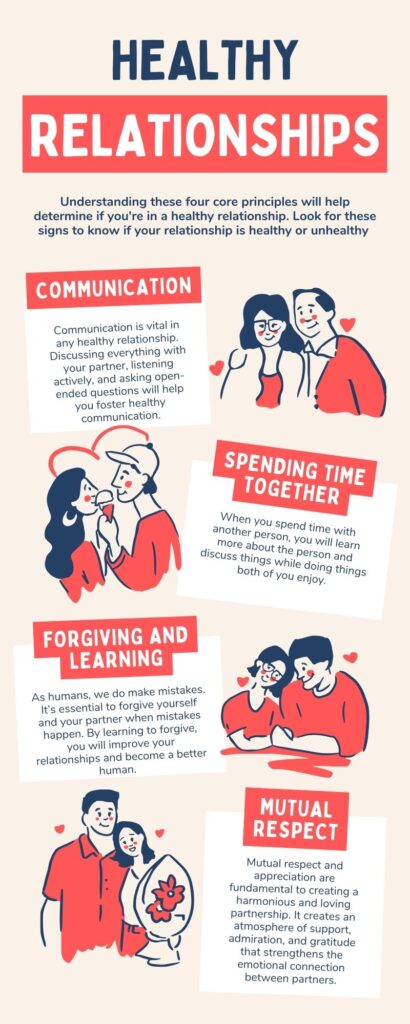We are a professional review company that receives compensation from companies whose products we review. We test each product thoroughly and give high marks only to the ones that are the very best. We are independently owned, and the opinions expressed here are our own.
Setting healthy boundaries in relationships is essential for fostering mutual respect, understanding, and emotional well-being. Boundaries define what you are comfortable with and how you would like to be treated by others. They help balance personal and relationship needs, preventing resentment and promoting a harmonious partnership. Whether you’re in a romantic relationship, friendship, or family connection, establishing boundaries can enhance communication and avoid conflicts. The article explores and discusses the importance of setting boundaries, practical steps to develop them, and tips for maintaining these boundaries effectively.
Are you ready to create a healthier, more respectful relationship? Let’s explore the essentials of setting healthy boundaries.
Understanding the Importance of Boundaries
Healthy boundaries are the foundation of any thriving relationship. They help individuals protect their personal space, needs, and values while fostering mutual respect and understanding. Here’s why boundaries are crucial:
Protecting Individuality and Autonomy
Boundaries help maintain your individuality and autonomy within a relationship. They ensure that you have the space to pursue your interests, goals, and personal growth without feeling overwhelmed or controlled by your partner. This sense of independence makes both partners feel fulfilled and happy.
Preventing Resentment and Conflict
Clear boundaries can prevent misunderstandings and resentment. Conflicts arising from unmet expectations or overstepped boundaries are less likely when both partners know and respect each other’s limits. This transparency allows for a smoother and more harmonious relationship where each person’s needs are acknowledged and respected.
Promoting Mutual Respect
Setting boundaries is a way to communicate your needs and expectations. It fosters mutual respect, as both partners understand and honor each other’s limits. This mutual respect creates a balanced relationship where both parties feel valued and heard, leading to a stronger and more supportive partnership.
Enhancing Emotional Health
Healthy boundaries contribute to emotional well-being by protecting your mental and emotional space. They help prevent burnout, stress, and emotional exhaustion, allowing you to maintain a positive and supportive relationship. When your emotional health is safeguarded, you are better equipped to handle the relationship’s ups and downs and support your partner.
Case Study: Sarah and Mike
Sarah and Mike had been married for five years when they realized their constant arguments were affecting their relationship. They often felt frustrated and misunderstood because they hadn’t communicated their needs and limits. After attending a couples’ workshop, they learned the importance of setting boundaries. Sarah needed time alone to recharge after work, while Mike needed quality time together to feel connected. By setting and respecting these boundaries, they found a balance that worked for both of them, reducing conflicts and increasing their happiness.
Understanding the importance of boundaries can help you see how crucial they are for a healthy relationship. Next, we will explore practical steps to establish these boundaries effectively.
Click here if you want to understand your partner’s boundaries too.

Steps to Establish Healthy Boundaries
Establishing boundaries requires clear communication, self-awareness, and mutual respect. Here are practical steps to set healthy boundaries in your relationship:
1. Self-Reflection and Awareness
Before communicating your boundaries to your partner, it’s essential to understand your own needs, values, and limits. Self-reflection helps you identify your need to feel comfortable and respected in the relationship.
- Identify Your Needs: Take some time to consider your emotional, physical, and mental needs. Ask yourself what makes you feel safe and respected. For example, you might need alone time after work to decompress or open communication to feel secure.
- Recognize Your Limits: Understand what behaviors or actions you’re uncomfortable with. This could include personal space, time commitments, and emotional boundaries. Knowing your limits helps you articulate them clearly to your partner.
2. Communicate Clearly and Assertively
Effective communication is critical to setting boundaries. Express your needs and limits clearly and assertively without being aggressive or confrontational.
- Use “I” Statements: Frame your needs and boundaries using “I” statements to avoid sounding accusatory. For example, say, “I need some time alone to recharge after work,” instead of “You always crowd me when I get home.”
- Be Specific: Clearly articulate what you need and why it’s essential. Specificity helps prevent misunderstandings. For instance, “I need at least 30 minutes of quiet time when I get home to unwind from the day.”
3. Mutual Respect and Understanding
Setting boundaries is a two-way process. It is crucial to respect your partner’s boundaries and expect them to respect yours in return.
- Listen Actively: Pay attention to your partner’s needs and limits. Validate their feelings and show that you understand and respect their boundaries. This mutual respect strengthens your relationship.
- Negotiate and Compromise: Sometimes boundaries might conflict. Be willing to negotiate and find a compromise that respects both partners’ needs. For example, if one partner needs quiet time and the other needs to talk about their day, you can agree on a specific time for both.
4. Consistency and Enforcement
Consistency is crucial for maintaining boundaries. Be firm in upholding your limits and address any boundary violations promptly.
- Enforce Your Boundaries: If your boundaries are crossed, address the issue immediately. Communicate how the behavior affects you and reiterate your needs. For instance, if your partner interrupts your alone time, calmly explain why it’s important and ask for respect.
- Stay Consistent. Consistency helps reinforce the importance of your boundaries and ensures they are respected over time. Uphold your boundaries consistently to create a stable and respectful environment.
5. Review and Adjust Boundaries
Relationships evolve, and so do your needs and limits. Review and adjust your boundaries regularly to ensure they continue supporting your well-being and your relationship’s health.
- Regular Check-Ins: Schedule regular check-ins with your partner to discuss your boundaries and any needed changes. This ongoing communication keeps both partners informed and respectful of each other’s evolving needs.
- Be Flexible: Be open to adjusting your boundaries as your relationship grows and circumstances change. Flexibility helps maintain harmony and mutual respect in the relationship.
Example: Anna and Tom
Anna and Tom realized that their differing social needs were causing friction in their relationship. Anna enjoyed socializing frequently, while Tom preferred quiet evenings at home. By discussing their needs and setting boundaries, they found a balance. Anna agreed to limit social outings to weekends, while Tom promised to join her for at least one monthly event. This compromise respected both their boundaries and strengthened their relationship.
Following these steps, you can establish healthy boundaries that promote mutual respect, understanding, and emotional well-being in your relationship. Next, we will explore practical tips for maintaining these boundaries effectively.

Practical Tips for Setting Boundaries
Maintaining healthy boundaries requires ongoing effort and communication. Here are some practical tips to help you uphold your boundaries effectively:
1. Practice Self-Care
Self-care is essential for maintaining your well-being and having the emotional strength to uphold your boundaries. Prioritizing self-care ensures you are in an excellent mental and physical state to manage your relationship healthily.
- Prioritize Your Needs: Make time for activities that nourish your mind, body, and soul. This could include hobbies, exercise, meditation, or simply relaxing.
- Set Aside Alone Time: Ensure you have regular time to recharge and reflect. Alone time helps you maintain your individuality and prevents burnout.
Click here for more insights on how self-care can help you set boundaries and improve relationships.
2. Establish Clear Communication Channels
Open and honest communication will help you maintain healthy boundaries. Ensure that you and your partner have clear and consistent ways to communicate your needs and concerns.
- Regular Check-Ins: Schedule regular discussions about how each of you feels regarding the boundaries you’ve set. This helps address any issues before they become more significant problems.
- Be Honest and Direct: When discussing boundaries, be honest and direct. Clearly articulate your needs and listen to your partner’s needs without judgment.
3. Seek Professional Help if Needed
Setting and maintaining boundaries can be challenging sometimes, especially if past experiences or deep-seated issues are involved. Seeking professional help can provide valuable support.
- Therapy and Counseling: A therapist or counselor can help you and your partner navigate boundary-setting and provide strategies to maintain them. This is especially helpful for addressing any underlying issues.
- Workshops and Books: Consider attending seminars or reading books on relationship boundaries. These resources can provide additional insights and techniques.
4. Be Patient and Persistent
Setting boundaries is not a one-time event but an ongoing process. It requires patience and persistence to ensure they are respected and maintained.
- Understand It’s a Process: Recognize that setting and maintaining boundaries takes time and effort. Be patient with yourself and your partner as you navigate this process.
- Reinforce Boundaries Consistently: Consistently reinforce your boundaries and address any violations immediately. This helps establish their importance and ensures they are respected.
Example: John and Lisa
John and Lisa struggled with setting boundaries around their work and personal time. John often brought work stress home, while Lisa needed a clear distinction between work and personal time to relax. They decided to establish a boundary where work discussions were limited to a specific time each evening. This allowed John to share his work concerns without overwhelming Lisa. Over time, they found that this boundary helped them both unwind and connect better after work.
Tips for Maintaining Healthy Boundaries:
- Practice Self-Awareness: Regularly check in to ensure your boundaries still serve your needs. Adjust them as necessary.
- Encourage Mutual Support: Support each other in maintaining your boundaries. Encourage your partner to prioritize their self-care and respect their limits.
- Celebrate Successes: Acknowledge and celebrate when you successfully uphold your boundaries. Positive reinforcement can motivate you to continue maintaining them.
Incorporating these practical tips into your relationship can help you effectively establish healthy boundaries. These strategies help create a balanced and respectful partnership where both feel valued and understood. Next, we will explore common challenges in setting boundaries and how to overcome them.

Common Challenges and How to Overcome Them
Setting and maintaining boundaries can come with its own set of challenges. Understanding these challenges is crucial for respecting and effectively respecting your boundaries. Here are some common challenges and strategies to address them:
1. Guilt and Fear of Rejection
One of the most common challenges in setting boundaries is dealing with feelings of guilt or fear of rejection. You might worry that setting boundaries will hurt your partner’s feelings or cause conflict.
- Recognize Your Right to Boundaries: You have the right to set boundaries to protect your well-being. Boundaries are a healthy part of any relationship and do not make you selfish or unkind.
- Communicate Compassionately: When setting boundaries, communicate with empathy. Explain why the boundary is essential for your well-being and reassure your partner that it’s not a rejection of them.
- Seek Support: Talk to a trusted friend, therapist, or support group about your feelings. Getting support can help you manage guilt and reinforce the importance of your boundaries.
Click here if you want practical tips to overcome your fear of rejection.
2. Dealing with Boundary Violations
Enforcing boundaries can be challenging, primarily if your partner is not used to them or frequently oversteps them.
- Address Violations Immediately: When a boundary is violated, address it immediately. Calmly explain how the behavior affects you and reiterate your boundaries.
- Be Consistent. Consistency is critical to maintaining boundaries. Continue to enforce your boundaries even if they feel uncomfortable at first.
- Seek Mediation: If boundary violations persist, consider seeking mediation from a therapist or counselor. A neutral third party can help facilitate the discussion and find a resolution.

3. Balancing Flexibility with Firmness
Finding the balance between being flexible and maintaining firm boundaries can be difficult. You want to be understanding and adaptable while ensuring your needs are met.
- Know Your Non-Negotiables: Identify which boundaries are non-negotiable and which can be flexible. This clarity helps you maintain firm boundaries where necessary while being adaptable in other areas.
- Communicate Clearly: When adjusting a boundary, explain the change clearly. Ensure both partners understand and agree to the adjustment.
- Reevaluate Regularly: Regularly assess your boundaries to ensure they meet your needs. Adjust them as necessary while keeping open communication with your partner.
Example: Alex and Jamie
Alex and Jamie struggled with setting boundaries around social activities. Alex enjoyed frequent social gatherings, while Jamie preferred quiet nights at home. Initially, Jamie felt guilty for setting boundaries around social time. However, by explaining that he needed downtime to recharge, Jamie could communicate his needs effectively. Alex and Jamie agreed on a compromise where they balanced social outings with quiet nights, respecting each other’s needs. By addressing boundary violations immediately and being consistent, they found a balance that worked for both.
Tips for Overcoming Boundary Challenges:
- Practice Assertiveness: Assertiveness helps you communicate your boundaries clearly and confidently without being aggressive—practice assertiveness techniques to improve your communication.
- Develop Coping Strategies: Learn and practice coping strategies to manage stress and emotions when setting and maintaining boundaries. Techniques like deep breathing, mindfulness, and journaling can help.
- Celebrate Progress: Acknowledge and celebrate your progress in setting and maintaining boundaries. Recognizing your efforts may motivate you to continue and improve.
By understanding common challenges and learning how to overcome them, you can effectively set and maintain healthy boundaries in your relationship. These strategies help create a balanced, respectful, and supportive partnership. Next, we will explore real-life examples and stories to illustrate the impact of healthy boundaries.

Real-Life Examples and Stories
Understanding how to set healthy boundaries can be enhanced by looking at real-life examples. These stories illustrate how different individuals and couples have successfully established boundaries to improve their relationships.
Case Study 1: Personal Space in Romantic Relationships
Example: Maria and John
Maria and John had been living together for a year when they started noticing friction in their relationship. Maria, who worked from home, felt overwhelmed by John’s need for constant interaction when he returned. On the other hand, John felt neglected and craved more attention from Maria.
Solution: They decided to set clear boundaries regarding personal space. Maria explained that she needed an hour of alone time after John returned home to unwind from her day. John agreed to give her that time, and, in return, Maria made a conscious effort to engage in quality time with him afterward. This balance allowed Maria to recharge and John to feel more connected, significantly reducing their conflicts.
Case Study 2: Work-Life Balance in Family Relationships
Example: Lisa and Mark
Lisa and Mark struggled to balance their demanding jobs with their family time. Both often brought work home, which interfered with their ability to spend quality time with their children and each other.
Solution: They decided to establish boundaries around work and family time. They agreed to stop working by 7 PM and dedicate the evenings to family activities and personal time. They also set specific weekends as “no work” periods to focus entirely on family. This boundary helped them create a healthier work-life balance, improving family interactions and reducing stress.
Case Study 3: Friendships and Emotional Boundaries
Example: Emma and Alex
Emma and Alex had been friends for years, but Emma often felt drained after their interactions because Alex frequently vented about her problems without reciprocating support.
Solution: Emma decided to set emotional boundaries. She told Alex that while she valued their friendship, she needed their conversations to be more balanced. Emma suggested they each take turns sharing their experiences and supporting each other. Alex respected this boundary, creating a more reciprocal and fulfilling friendship for both.
Case Study 4: Time Management in Romantic Relationships
Example: Tom and Sarah
Tom loved spontaneous plans and activities, while Sarah preferred a more structured schedule. This difference often led to last-minute cancellations and frustrations.
Solution: They established boundaries around their planning. Tom agreed to respect Sarah’s need for advance notice by planning activities at least a week ahead. In turn, Sarah made an effort to be more flexible occasionally for spontaneous outings. This compromise made them feel respected and enjoy their time together more.
Case Study 5: Financial Boundaries in Marriage
Example: Steve and Laura
Steve and Laura had different spending habits, which led to frequent arguments about finances. Steve was a saver, while Laura enjoyed occasional splurges.
Solution: They decided to set clear financial boundaries and create a budget together. They allocated specific amounts for savings, essential expenses, and discretionary spending. Both agreed to discuss any large purchases beforehand. This boundary helped them manage their finances better and reduced financial stress, allowing them to focus on their relationship.
Tips for Implementing Boundaries Based on Real-Life Examples:
- Communicate Openly: Ensure both partners understand the need for boundaries and agree on them. Open communication is critical to mutual respect and understanding.
- Be Flexible and Compromise: Find a middle ground for both partners. Flexibility and a willingness to compromise can help set effective boundaries.
- Regularly Review Boundaries: As relationships evolve, so do the needs and boundaries. Regular check-ins help ensure boundaries remain relevant and respected.
By looking at these real-life examples, it becomes clear how setting healthy boundaries can positively impact various aspects of relationships. Boundaries help protect individual needs, reduce conflicts, and enhance mutual respect and understanding.

How to Set Healthy Boundaries in Relationships: Conclusion
Setting healthy boundaries in relationships is essential for fostering mutual respect, understanding, and emotional well-being. Boundaries help protect your personal space and needs, prevent resentment and conflict, and promote a balanced and fulfilling partnership. By understanding the importance of boundaries and implementing practical steps to establish them, you can create a more supportive and harmonious relationship.
Key Points Recap:
- Understand the Importance of Boundaries: Boundaries protect individuality, prevent conflict, promote mutual respect, and enhance emotional health.
- Establish Boundaries: Self-reflect to understand your needs, communicate clearly, respect each other’s boundaries, be consistent, and regularly review and adjust boundaries.
- Practical Tips: Practice self-care, establish clear communication channels, seek professional help, and be patient and persistent.
- Overcome Common Challenges: Address guilt and fear of rejection, deal with boundary violations promptly, and balance flexibility with firmness.
- Learn from Real-Life Examples: Real-life stories demonstrate how effective boundaries can improve personal space, work-life balance, emotional support, time management, and relationship stability.
Final Thoughts:
Maintaining healthy boundaries requires ongoing effort and open communication. By setting and respecting boundaries, you and your partner can enjoy a more balanced, respectful, and supportive relationship. Boundaries are not about building walls but about creating a safe, nurturing space where both partners thrive.
Encourage a continuous dialogue about boundaries, regularly check in with each other, and be open to adjusting them as your relationship evolves. Embrace the journey of setting healthy boundaries to strengthen your connection and ensure both partners feel valued and understood.
Here’s to a healthier, happier, and more fulfilling relationship through the power of healthy boundaries!
Additional Resources That You May Find Helpful:
- Book Recommendation: “Boundaries: When to Say Yes, How to Say No to Take Control of Your Life” by Dr. Henry Cloud and Dr. John Townsend
- Article: How to Communicate Effectively in Relationships
- Article: 5 Unconventional Ways to Revitalize Your Relationship

To your success,




What do you think about the article you've just read? Please tell me below.